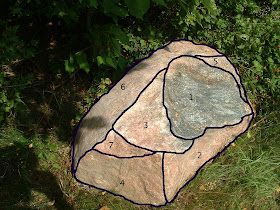Erratic boulder, Blido, Sweden (click to enlarge)
I'm often asked why, if the bluestones at Stonehenge are glacial erratics, they aren't covered with scratches (striations) and glacial facets which would demonstrate for all to see that they have been transported in or on glacier ice. Partly, that's because dolerite does not striate very easily -- it's very coarse, and because the component crystals are quite large, when glacial abrasion occurs on a dolerite surface the rock crumbles rather than becoming smooth. On the other hand rhyolite does smooth reasonably well, and I have seen striations on some ice-smoothed surfaces, on Carn Alw for example. But there is not a lot of rhyolite exposed above the surface at Stonehenge. Some sandstones can smooth and accept striations -- maybe the two sandstone stumps in the bluestone circle may give some clues as and when anybody gets to look at them. Ashes are sometimes too soft -- but given the right circumstances maybe we could find glacial scratches on the smoothed faces of some Stonehenge monoliths.
To give us some idea how complex are the effects of glacial transport on contained erratics, have a look at the boulder above. We dug it up last year from the thick till near our summer cottage in Sweden. This boulder has at least nine facets on it -- the seven that I have labelled, and two that we can't see. Number 1 probably shows the original shear face -- probably this boulder was sheared off the bedrock roughly along a weak contact between pink rock and bluish-grey rock. (I hesitate to give them names -- the pink rock is thought to have been Pre-Cambrian granite originally, but there has been tremendous metamorphism since it was originally emplaced. The bluish-grey rock is altered too.) You can click to seee the other facets more clearly -- they are all sheared or fractured faces of different ages. It's difficult to give them relative dates. Note that some are VERY rough, while others have been subject to varying degrees of abrasion and smoothing. The smoothest facet of all is Number 6 -- beautifully abraded, with very clear striations and also chatter-marks or pressure fractures created by tools being forced down onto the rock surface. If a tool is very big and the pressure exerted is very large too, then the whole boulder will be split or fractured, and thence reduced in size. And we will have another facet on the boulder. If this process goes on for long enough, the boulder is reduced to a collection of smallish bits and pieces, gravel and sand. If the boulder is protected, it can be carried for hundreds of kilometres without further modification.
This is typical of what happens to a boulder being carried at the base of a glacier. Boulders carried englacially or supraglacially are affected by a different set of processes.


Brian , Would you happen to have any pics of the erratics from the Preslis found at Lampeter Velfrey or Llandewi ridge ..
ReplyDeleteNo -- afraid not.
ReplyDeleteHello Geo and Brian,
ReplyDeletePlease excuse my ignorance but as there are several Llandewi's could you tell me the location of the above mentioned Llandewi ridge, and if possible where the Preseli erratics were found.
It would be greatly appreciated.
Ta
George
ReplyDeleteHave a look at this post of mine from 20 April 2010 -- the best source is Griffiths:
http://brian-mountainman.blogspot.com/2010/04/pembrokeshire-erratic-routes.html
Griffiths's work was pretty well in tune with the work by Cantrill, Strahan and the other Geological Survey people who did the original GS mapping before the First World. I have no copies of the records of which erratics were found, and where, and what they were made of..... war. But Griffiths was a pretty fastidious worker, and I recall being impressed when I read his thesis very many years ago!
Oops -- sorry. That should have been 9 April 2010.
ReplyDeleteGeorge , Strahan et al (1914) mentions both sites and Thorpe ,Williams -Thorpe followed up with an examination of the Lampeter Velfrey erratics (between SN 155 148 and SN 157 155 . I have looked on geograph and no pics there ).They describe the erratics as being a varied assemblage ...spotted dolerite ,rhyolite (?) lavas and pyrocalstic rocks . A chemical study of the dolerites showed that the major and trace element compositions were identical to Preseli dolerites of the Carnmenyn/Carngyfrwy area .There was no examination of the Llandewi ridge examples and therefore no grid refs the only other info was that they were at the eastern end of the ridge .I imagine it might the Llandewi c. SN 148 168 .
ReplyDeleteHello Geo and Brian,
ReplyDeleteThanks to you both.